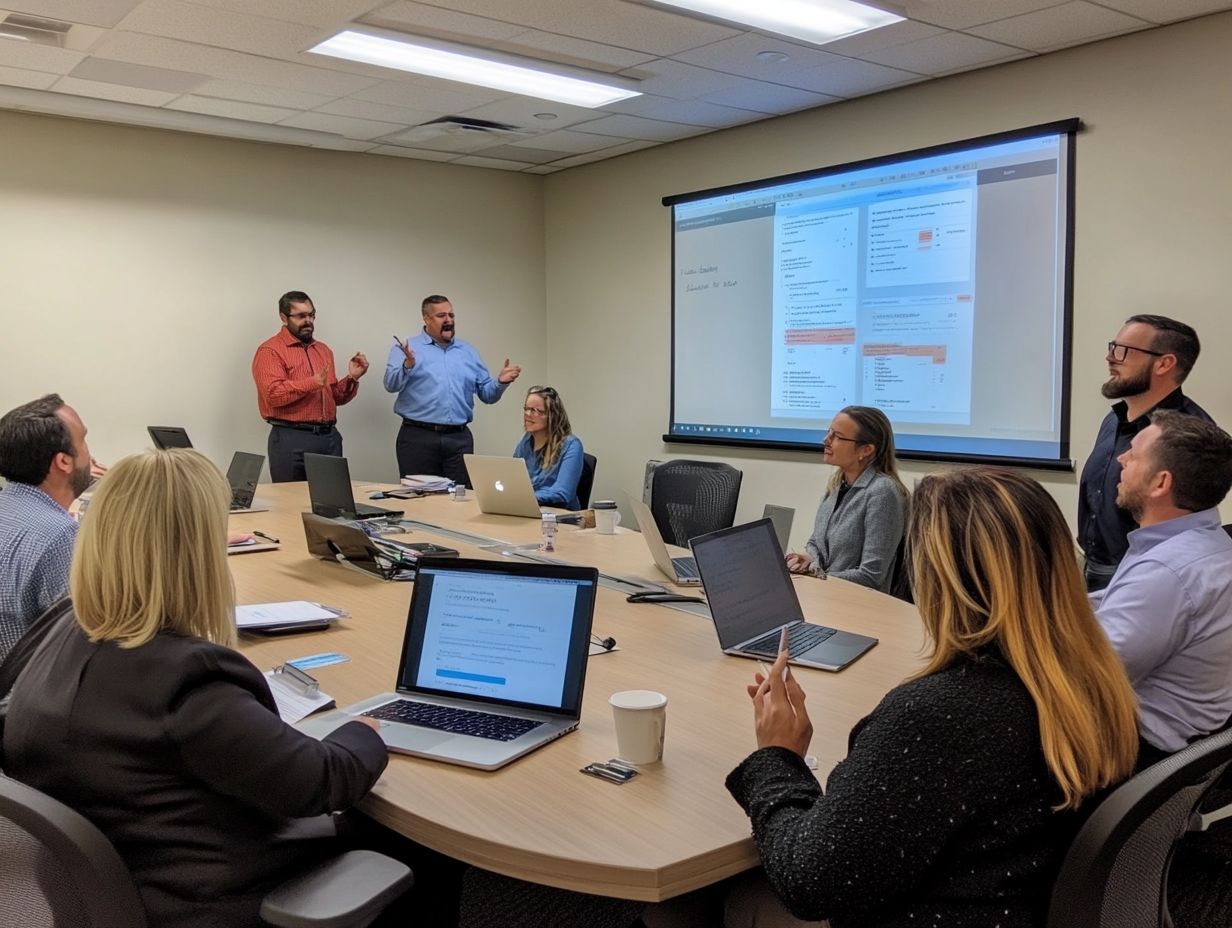“5 Things CRM Users Should Know Before Training”
In today’s fast-paced business landscape, effective Customer Relationship Management (CRM) is essential for your success.
Your journey to mastering a CRM system begins well before the training sessions kick off. Understanding the purpose of CRM training, familiarizing yourself with the system, and identifying key features are fundamental first steps that you can’t overlook.
Get ready to discover ten crucial aspects you should know before diving into training, ensuring that your team is fully prepared to unlock the full potential of your CRM system.
Explore these insights to maximize your training efforts and drive your business growth forward.
Contents
- Key Takeaways:
- 1. Understand the Purpose of CRM Training
- 2. Familiarize Yourself with the CRM System
- 3. Identify Key Features and Functions
- 4. Prepare for Data Migration and Integration
- 5. Determine the Best Training Method for Your Team
- 6. Set Clear Goals and Expectations
- 7. Involve Stakeholders in the Training Process
- 8. Allocate Enough Time for Training
- 9. Provide Ongoing Support and Resources
- 10. Encourage User Adoption and Feedback
- How Can CRM Training Benefit Your Business?
- Frequently Asked Questions
- What are the key features of a CRM system that users should know before training?
- Why is it important for CRM users to have a clear understanding of their company’s goals and objectives?
- How can CRM users get ready for training?
- Why involve key team members in CRM training?
- How should CRM users prepare for training?
- What challenges might CRM users face during training?
Key Takeaways:
- Understand the purpose of CRM training to use the system effectively.
- Familiarize yourself with the CRM for easy navigation and key features.
- Identify the best training methods for your team to enhance learning.

1. Understand the Purpose of CRM Training
Understanding the purpose of CRM training is essential for successful implementation that aligns with your organization s learning objectives and fosters user engagement. This ultimately enhances productivity and drives sales outcomes.
By clearly identifying training expectations and addressing skill gaps, you can create a productive training environment that fulfills both employee and organizational goals.
Experts like Michael Taylor emphasize that comprehensive training should be viewed as an ongoing journey rather than a one-off event. Engaging users through structured learning that connects with CRM functionalities boosts their confidence and significantly reduces resistance to change.
When you align your training efforts with the specific features of the CRM system, you bridge the knowledge gap, encouraging clarity and competence among your team. This alignment paves the way for seamless software adoption and enhances user productivity and engagement, leading to improved overall performance and a higher return on investment.
2. Familiarize Yourself with the CRM System
Familiarizing yourself with the CRM system, like Salesforce, lays the groundwork for effective onboarding training and ensures a seamless user experience during software adoption.
Understanding key features such as contact management, lead tracking, and reporting tools is crucial for fully harnessing the system s potential. It s wise to explore customization options and integration capabilities with other applications, as this enables you to streamline workflows and boost productivity.
By leveraging training resources and tutorials, you accelerate your learning curve and enable yourself to implement best practices with confidence.
Engaging in community forums and seeking advice from seasoned users can offer valuable insights, making your overall experience more intuitive and rewarding as you manage customer relationships.
3. Identify Key Features and Functions
Identifying the key features and functions of your CRM system is crucial for maximizing user engagement and optimizing your sales processes. This ensures that data entry becomes streamlined and efficient.
Focus on aspects like comprehensive data management, which allows you to organize customer information seamlessly and access it with ease. The importance of reporting tools cannot be overstated; they offer valuable insights into sales trends and performance metrics, enabling your team to make informed decisions.
Pay close attention to sales forecasting capabilities, as they enable you to predict future sales and revenue, guiding your strategic planning. Each of these features plays a vital role in enhancing performance, driving sales growth, and strengthening customer relationships by ensuring that every interaction is rooted in relevant and up-to-date information.
4. Prepare for Data Migration and Integration
Preparing for data migration and integration is crucial in your Customer Relationship Management (CRM) implementation journey. This ensures that your CRM data is accurately transferred and seamlessly integrated into the new system, making your digital adoption efforts more effective.
This foundational step minimizes potential disruptions and enhances the overall user experience during the transition. Thorough planning is essential to assess existing data for accuracy and relevance, while also identifying gaps that may impact integration.
Engaging stakeholders early in the process fosters collaboration and helps create a smoother transition. Establishing clear protocols for mapping data fields is key to maintaining consistency.
By following these best practices, you ensure that users have reliable access to information, ultimately bolstering performance support and encouraging a positive response to the new system.
Get started on your preparation today!
5. Determine the Best Training Method for Your Team
Determining the best training method for your team is crucial for effective CRM training. By focusing on contextual training and task-specific tutorials tailored to user needs, you can significantly enhance learning outcomes.
Exploring a variety of training methods can further elevate the learning experience. Online guidance provides flexibility, granting team members the freedom to learn at their own pace, while interactive Q&A sessions deliver immediate answers to pressing questions, deepening their understanding.
Consider incorporating hands-on workshops to foster collaboration and practical application of new skills. It s essential to assess individual learning preferences within your team, as a diverse group may thrive under different approaches.
By identifying skill gaps and aligning training expectations with suitable methodologies, you will boost proficiency and ensure your team s adaptability and confidence in using the CRM system effectively.
Your team’s growth starts here explore the best training methods now!
6. Set Clear Goals and Expectations

Setting clear goals and expectations is crucial for your CRM training program. This approach guides you and your team toward the desired outcomes while enhancing user support throughout the learning journey.
By establishing measurable objectives, you can ensure that the training remains relevant and directly tied to your business success. It s about clearly defining what success looks like consider reducing response times or boosting customer engagement metrics.
For example, you might set a goal for your team to increase their customer follow-up rate by 25% within three months. To communicate these expectations effectively, hold regular check-ins, set tangible deadlines, and provide ongoing feedback.
Sharing success stories about how achieving these goals positively impacts the company can serve as a powerful motivator for your employees, encouraging them to fully engage with the training process.
Let’s make this a success set your goals today!
7. Involve Stakeholders in the Training Process
Involving stakeholders in the training process is essential for fostering management buy-in and enhancing the overall effectiveness of your CRM implementation. This approach ensures that everything aligns perfectly with your organizational goals and meets the training needs of your employees.
When stakeholders such as department heads, team leads, and end-users actively engage in developing and delivering training programs, they can offer invaluable insights into specific challenges and requirements. This collaboration leads to more tailored training sessions and boosts the relevance of the material being presented.
To effectively engage these key players, consider adopting strategies like:
- Hold regular feedback sessions to collect insights.
- Organize collaborative planning meetings.
- Create open forums where stakeholders can express their concerns and suggestions.
This inclusive approach not only enables your stakeholders but also cultivates a sense of ownership, ultimately driving better adoption and utilization of CRM tools throughout your organization.
Engage your stakeholders now for a smoother training process!
8. Allocate Enough Time for Training
Allocating adequate time for Customer Relationship Management (CRM) training is essential for creating an environment that nurtures continuous learning and boosts user engagement. A structured training schedule allows you to grasp concepts at a comfortable pace, significantly reducing feelings of overwhelm.
Effective time management captures your attention and enhances the retention of information. Incorporating short breaks during sessions helps maintain focus, ensuring you remain invested in the material.
Reinforcing key ideas through activities or discussions at the end of each segment solidifies your understanding. Establishing a clear agenda helps manage your time wisely during sessions, ensuring every necessary topic is covered thoroughly.
9. Provide Ongoing Support and Resources
Ongoing support and resources are crucial for reinforcing your CRM training. This access to performance support and user feedback mechanisms promotes continuous learning.
Create a comprehensive knowledge base that serves as a one-stop shop for information and best practices. User forums can cultivate a sense of community where you and others can share tips and tackle challenges together.
Continuous training resources such as webinars and interactive tutorials keep you engaged and confident in your skills. This exciting approach empowers you and fosters a culture of continuous improvement and shared knowledge.
10. Encourage User Adoption and Feedback
User adoption and feedback loops are essential training best practices that can significantly enhance your CRM return on investment (ROI) and improve sales outcomes. This alignment between user needs and system functionality is vital.
Actively engaging users in the feedback process uncovers areas for improvement and allows individuals to take ownership of their learning journey. This collaboration creates a tailored training experience that resonates with real-life applications, bridging the gap between expectations and outcomes.
You can gather insightful feedback through surveys, focus groups, or regular check-ins. This provides users a platform to voice their concerns and suggestions. Cultivating a culture of open communication ensures your training programs evolve continuously, remaining relevant and impactful in meeting users needs.
How Can CRM Training Benefit Your Business?
CRM training can profoundly enhance your business by refining sales processes, boosting productivity, and ultimately increasing your CRM ROI. This sets the stage for sustained organizational learning and growth.
Equipping your employees with thorough knowledge of CRM tools and best practices can lead to a remarkable 30% increase in your sales team s efficiency. Research shows that companies investing in CRM training see a 20% improvement in customer retention rates, translating to increased revenue over time.
Enhanced data management allows for timely insights that support strategic decision-making, creating an agile environment where adaptability is key. With well-trained personnel, you streamline operations and foster a collaborative atmosphere that drives innovation, significantly elevating overall organizational performance.
What Are the Different Types of CRM Training?

Different types of CRM training, including onboarding and ongoing performance support, are tailored to meet your diverse needs and facilitate seamless digital adoption across your organization.
Onboarding training helps you become acquainted with the system s functionalities, ensuring you feel at ease navigating the interface from day one.
Ongoing performance support offers continuous learning opportunities through workshops or online resources, helping you stay informed about new features and best practices.
Specialized training sessions designed for sales teams or customer service representatives provide targeted strategies that align with your unique roles, fostering a more efficient CRM experience overall.
Ready to start your CRM training journey? Embrace the benefits that CRM training can provide to your business!
Discover How to Measure CRM Training Success!
Measuring the success of your CRM (Customer Relationship Management) training requires a careful evaluation of user engagement and performance support against your established training expectations and organizational goals.
To truly grasp the effectiveness of these training programs, turn to a variety of metrics and methods. Surveys can yield valuable insights into user satisfaction and perceived value. Meanwhile, performance tracking can highlight shifts in productivity and demonstrate the overall impact on your sales targets.
Analyzing user feedback, such as user satisfaction surveys and performance metrics, will help you identify recurring challenges as well as success stories. This provides a nuanced view of the training’s strengths and weaknesses.
By combining these approaches, you can effectively adapt your training initiatives to better meet the needs of your teams and drive significant improvements in CRM utilization.
What Are the Common Challenges in CRM Training?
Common challenges in CRM training involve bridging the knowledge gap, addressing the skill gap among users, and ensuring that user engagement remains consistent throughout the training process.
You might find that varying levels of technological proficiency among employees can hinder the effectiveness of your training programs. With the fast-paced nature of business, teams often feel pressed for time, making it challenging to dedicate adequate hours for thorough training.
To address these challenges effectively, it s essential to adopt a tailored training approach. Conducting skill assessments before training begins can pave the way for personalized learning pathways. Regular check-ins and feedback sessions significantly enhance engagement and retention.
This ensures that all users not only grasp the intricacies of the CRM system but also feel enabled to leverage it to its full potential.
How Can You Overcome Resistance to CRM Training?
Overcoming resistance to CRM training demands effective change management strategies, getting management on board, and incorporating user feedback to refine the onboarding experience.
Recognizing the psychological factors at play can greatly facilitate the transition for employees. Resistance often arises from a fear of the unknown, worries about job security, or a lack of perceived value in the new system.
To tackle these challenges, it s essential to provide a clear rationale for the CRM implementation and involve your staff in the decision-making process, enhancing their sense of ownership.
Regular communication and transparency about the CRM s benefits, along with ongoing support, can significantly reduce anxiety. Establishing a mentorship system where more experienced users guide their peers can create a collaborative environment, ultimately smoothing the shift toward embracing the new technology.
What Are the Best Practices for CRM Training?
Implementing best practices for CRM training, such as effective instructional design and a commitment to continuous learning, can significantly elevate your user support and overall training effectiveness.
By integrating interactive elements like simulations and real-life scenarios, you allow learners to actively engage with the content, making the training not just relatable but truly memorable.
Fostering an environment of open communication encourages users to ask questions and share their experiences, reinforcing their understanding in a meaningful way.
Incorporating regular check-ins and refresher courses ensures that skills stay relevant and are seamlessly applied in day-to-day tasks.
This ongoing dedication to skill enhancement not only boosts retention rates but also enables users to navigate the CRM system with confidence, ultimately leading to improved productivity and satisfaction in their roles.
Watch this video to learn more about maximizing CRM training!
Frequently Asked Questions
What are the key features of a CRM system that users should know before training?

Before undergoing CRM training, users should have a basic understanding of the system’s key features, including lead and contact management, sales forecasting, and customer communication tracking.
Why is it important for CRM users to have a clear understanding of their company’s goals and objectives?
In order to effectively utilize a CRM system, users should have a clear understanding of their company’s goals and objectives. This will help them tailor their training to meet the specific needs and objectives of their organization.
Are you ready to unlock the full potential of your CRM? Start enhancing your CRM skills today and watch your team’s productivity soar!
How can CRM users get ready for training?
Users can start by exploring self-guided tutorials and online resources. Practicing with a demo version of the software is also a great way to learn.
Why involve key team members in CRM training?
Key team members, like managers and leaders, play a crucial role in making sure the CRM system is used effectively. They can share valuable insights and feedback during training.
How should CRM users prepare for training?
CRM users should review their company’s goals first. They should also jot down specific questions to focus on during training sessions.
What challenges might CRM users face during training?
Users may struggle with understanding the system or adapting to new workflows. You can overcome these challenges with effective training and support.






